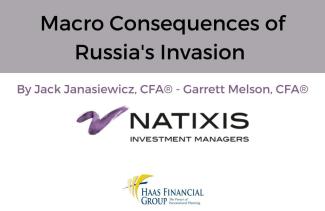
Macro Consequences Of Russia's Invasion
Please find commentary as of 3/7/2022 by Jack Janasiewicz, CFA®, Portfolio Manager, and Garrett Melson, CFA®, Portfolio Strategist, Natixis Investment Managers Solutions.
As the Russia-Ukraine crisis intensifies and uncertainty builds across global markets, we have pulled together some of our thoughts regarding direct and indirect risks, sanctions, oil prices, commodities, and investor sentiment. Of course, it goes without saying that this situation is very fluid and things can change by the hour.
What does Vladimir Putin want?
Good question. At this point, there really appears to be no path for a “victory” – however one defines that. For starters, Putin wants Ukraine President Volodymyr Zelensky out, and the annihilation of the Ukrainian military. Neither has been achieved as of today (March 6). Therefore, he appears to need an off ramp. Seeing that he really has none, he is now forced to double down.
What is Putin’s likely list of demands? Ukraine will probably need to concede Crimea to Russia and a land bridge to Odessa. The Donbas region will probably need to be recognized as Russian. Also, Ukraine joining NATO will need to be sworn off. Putin also wants regime change. But ousting Zelensky and installing a puppet government will never lead to authority or credibility in Ukraine. With the tenacity and will of the Ukrainian people, he will never be able to govern Ukraine with an occupation. It will be nearly impossible.
Longer term, should Russia continue its military push, we could very well see the Zelensky government move to Lviv and then to Poland where they could operate in exile. If Russia’s occupation fails, the Zelensky government could then return.
Unintended consequences of Russia’s invasion
· The US, UK and EU are now unified like never before
· NATO has been rekindled and has a new outlook on life
· Ukraine is being pushed more and more to the West
· Military spending in Europe is now expected to ramp back up
· National debt brake across the EU might be amended to allow more government-financed spending
Sanction effects
The goal of the West is to impair Russia’s economic and military development over time, in order to limit Putin’s ability to repeat this move in the future. The immediate effect is likely to push Russia more and more eastward to become more dependent on China.
With the US move to ban high-tech exports such as semiconductor exports to Russia, Russia’s attempted shift from a fossil fuel-driven economy to a tech-based one faces headwinds. We suspect Russia will likely turn to Chinese chip technology, but the Chinese chips are considered to be generations behind that of the US.
For the sanctions to be effective, the Russian population will need to blame Putin for their hardships, not the West. We’ve already seen the Duma approve a 15-year prison sentence on anyone reporting any alternative narrative to the war other than those farcical ones approved by the Putin regime. Rumors of instituting martial law are also running rampant.
While the multilateral financial sanctions ramped up quite quickly, the more eye-opening impact has been the self-sanctioning taking place by the private sector side. Multinational firms are choosing to divest their Russia ventures, as well as refusing to do business with Russia-linked firms.
Sanctions are an important tool for negotiations – think of them as a carrot and stick approach:
· If you do this, we will do this. If you withdraw from Ukraine, we will rescind banning your banks from SWIFT.
· But with Putin seemingly doubling down, the odds of the sanctions becoming permanent continue to rise.
· From a technical perspective, Europe must reapply these sanctions every 6 months and for the US, it’s every 12.
· And with self-sanctioning, reversals may never even occur. We’ve already seen many large oil names permanently exiting the market and many other companies suspending sales with no guarantee these decisions will be promptly reversed.
· The question then shifts: With rising energy costs, how long will the population be willing to assume the financial hit before they start to withdraw their support for their local politicians?
Energy exports: the Holy Grail
· Given that the US does very little business with Russia, unilateral sanctions would be not nearly as effective. Europe needs to be the driving force behind this.
o Should the US ban Russian gas imports, this could begin to drive a wedge between the US and its Western allies.
· Europe limiting or embargoing Russian imports is challenging.
o The impact across the EU varies from product to product.
o Because of this, it will be challenging to find a consensus across all member EU states.
o The EU itself does not have the ability to impose energy policy on national governments.
o As such, any agreement on the direction of limits or embargoes would need unanimity across all member states unless some were prepared to go the course solo.
· The move to remove some Russian banks from the SWIFT payment messaging system was calculated, as Western allies have been loath to choke off the Russian energy sector.
o The incremental risk – Putin decides to stop supplying gas to Europe.
o Think about it – he is receiving revenues from these sales that he simply cannot use. So what’s the point?
· Offsetting this backdrop – winter is almost over and it has been less severe.
o Should a ban persist, however, this would prevent gas reserves from being stockpiled for the next winter season.
· While the US and its allies have not imposed penalties on Russian oil and gas, the self-sanctioning aspect has made an impact:
o Russian oil loadings for March show a sharp drop with a number of ship owners reluctant to act.
o The extent to which this self-sanctioning accelerates and widens, we believe, will be a key linchpin in the severity and duration of the energy shock.
Commodities crunch
Certainly, oil price increases could bite into global growth and cause further inflationary pressures. But here are some other specific commodities that may be at risk:
· Platinum and palladium – impacting catalytic converters and putting auto production at risk.
· Neon – a major export from the region and a key input for semiconductor production.
· Wheat, corn, and sunflower are all at risk.
o Many emerging economies are wheat importers and likely to be hurt more from rising food costs. In fact, Egypt, Indonesia, and Turkey are the largest wheat importers in the world.
· Ammonia – with natural gas prices on the rise, it is now becoming cost-prohibitive to make.
· Potash – Russia and Belarus account for about one-third of global trade in this commodity – a key ingredient in fertilizer.
How can the world replace oil supply?
· Should Russian oil get cut off, there are some means to replace the supply.
· Iran nuclear deal – Iran has some 180 million barrels ready to go, sitting on floating ships already. They could also ramp up a large amount of supply over the course of a year. So it seems that it would be in Russia’s best interest to make fresh demands here to slow the progress of negotiations – which is exactly what they are doing.
· Global Strategic Petroleum Reserves (SPRs) stand at about 4.16 billion barrels, with 1.5 billion of that held by governments. If needed, roughly 60 million barrels could be delivered per month.
· OPEC has spare capacity to ramp up some 1.6 million barrels per day.
· US shale could ramp up – but producers have commented that they cannot produce output fast enough to compensate for lost Russian oil, citing lack of labor and raw material issues like steel and cement.
· Libya’s political crisis is causing output to slide.
· The US has sent a delegation to Venezuela – the highest level trip in years. The reasoning, it seems, is to isolate one of Moscow’s remaining allies in the world, as well as possibly replace Russian oil imports.
Oligarch offensive
Western countries have begun creating task forces to determine what Russian oligarch owns what. Jets and yachts being seized makes for good theater. And the court of public opinion is certainly having an impact here, with many high-profile seizures hitting the news in the past week. But will the Russian elite apply enough pressure to the Putin regime to effect change? Thus far, the answer is NO. Most oligarchs have called for an end to the escalation but have fallen well short of criticizing Putin. What’s their upside in doing so? They know who made them rich and they know who can make their life difficult.
Demise of the US dollar? Not so fast
With the US dollar becoming weaponized, there has been quite a bit written about the overall impact. The common thread is that more and more countries will begin to move away from the USD and weaken its status as the world’s reserve currency. We’ve heard this take for decades now and it has been nothing more than clickbait.
China’s CNY has been the rumored replacement for those seeking diversification. We believe the flaw in this logic is that the CNY is simply not a fully convertible currency. With capital restrictions on the currency, it hinders its liquidity, making it a nonstarter. CNY accounts for just 3% of all foreign currency transactions – while the USD accounts for over 40%. Also, to replace the buck on the global stage you would have to replace contracts and payment systems that have been in place for years. This would be a decade-long venture and not something that can be done overnight.
More importantly, in times of global crisis, having one currency dominate the international financial system actually makes it easier to backstop the system. With the Fed always standing at the ready to provide global liquidity for the USD, this has been the saving grace time and time again, preventing a major collapse of the global financial system. We believe this backstop is an important misunderstanding for those calling for the end of the US dollar as the reserve currency of the world.
Market perspectives
· US equities have been quite resilient, all things considered. Up until now, Russia has been more of a market event for US firms rather than an economic one.
· The euro continues to slip relative to the dollar with higher oil prices. This creates the doom loop – oil prices rise, EUR weakens which puts increased upside pressure on inflation as a weaker EUR makes imports more expensive. Also, commodities are priced in USD and rising prices against a falling EUR only exacerbate the issue.
· Surging prices across all commodities will eat away at consumer purchasing power and exacerbate the inflation problem.
o Keep in mind, however, that US household and corporate balance sheets have never been better – helping to cushion rising prices.
o Stagflation calls might be getting a bit ahead of themselves in the US. Nominal growth is at a much higher starting point these days, and this should not be forgotten. Real rates are still negative. And the US is now a major oil producer, not importer.
· Energy has turned from unloved to crowded. We think any resolution could see a sharp correction in energy prices given positioning.
· Financial contagion still seems fairly muted and the odds of a Lehman-style meltdown remain low.
· Europe is the most exposed – there are upside risks to inflation and downside risks to growth. Plain and simple. Banks may also be at risk, not from Russia exposure, but from slower economic growth.
Big picture themes
Overall, it is tough to see a resolution of the Russia-Ukraine crisis anytime soon. We expect it could be several more months. With that in mind, the macro themes we expect to play out include:
· Increased defense and cybersecurity spending
· Elevated commodity prices for an extended period
· Supply chain headaches persisting
Final thoughts
Will Putin declare war on a NATO country? This would certainly provide him additional cover, framing some “incident” as a means to justify actions to the Russian people. The good side to this: NATO is well aware and will likely not play along. Again, this unfortunate situation is very fluid and things can change by the hour. With that in mind, our views and market perspectives may change as well.
This material is provided for informational purposes only and should not be construed as investment advice. The views and opinions contained herein reflect the subjective judgments and assumptions of the authors only and do not necessarily reflect the views of Natixis Investment Managers, or any of its affiliates. The views and opinions are as of March 7, 2022 and may change based on market and other conditions. There can be no assurance that developments will transpire as forecasted, and actual results may vary.
All investing involves risk, including the risk of loss. Investment risk exists with equity, fixed income, and alternative investments. There is no assurance that any investment will meet its performance objectives or that losses will be avoided. Investors should fully understand the risks associated with any investment prior to investing.
CFA® and Chartered Financial Analyst® are registered trademarks owned by the CFA Institute.
This material may not be redistributed, published, or reproduced, in whole or in part. Although Natixis Investment Managers believes the information provided in this material to be reliable, including that from third party sources, it does not guarantee the accuracy, adequacy or completeness of such information.
This document may contain references to copyrights, indexes and trademarks that may not be registered in all jurisdictions. Third party registrations are the property of their respective owners and are not affiliated with Natixis Investment Managers or any of its related or affiliated companies (collectively “Natixis”). Such third party owners do not sponsor, endorse or participate in the provision of any Natixis services, funds or other financial products.
Provided by Natixis Distribution, LLC, 888 Boylston St., Boston, MA 02199. Natixis Investment Managers includes all of the investment management and distribution entities affiliated with Natixis Distribution, LLC and Natixis Investment Managers S.A. Natixis Advisors, LLC provides advisory services through its division Natixis Investment Managers Solutions. Advisory services are generally provided with the assistance of model portfolio providers, some of which are affiliates of Natixis Investment Managers, LLC.
4476775.1.1
Exp. 4/30/2022
https://www.im.natixis.com/us/markets/macro-economic-consequences-of-russias-invasion
Tracking # T003718

